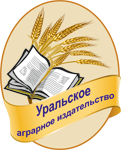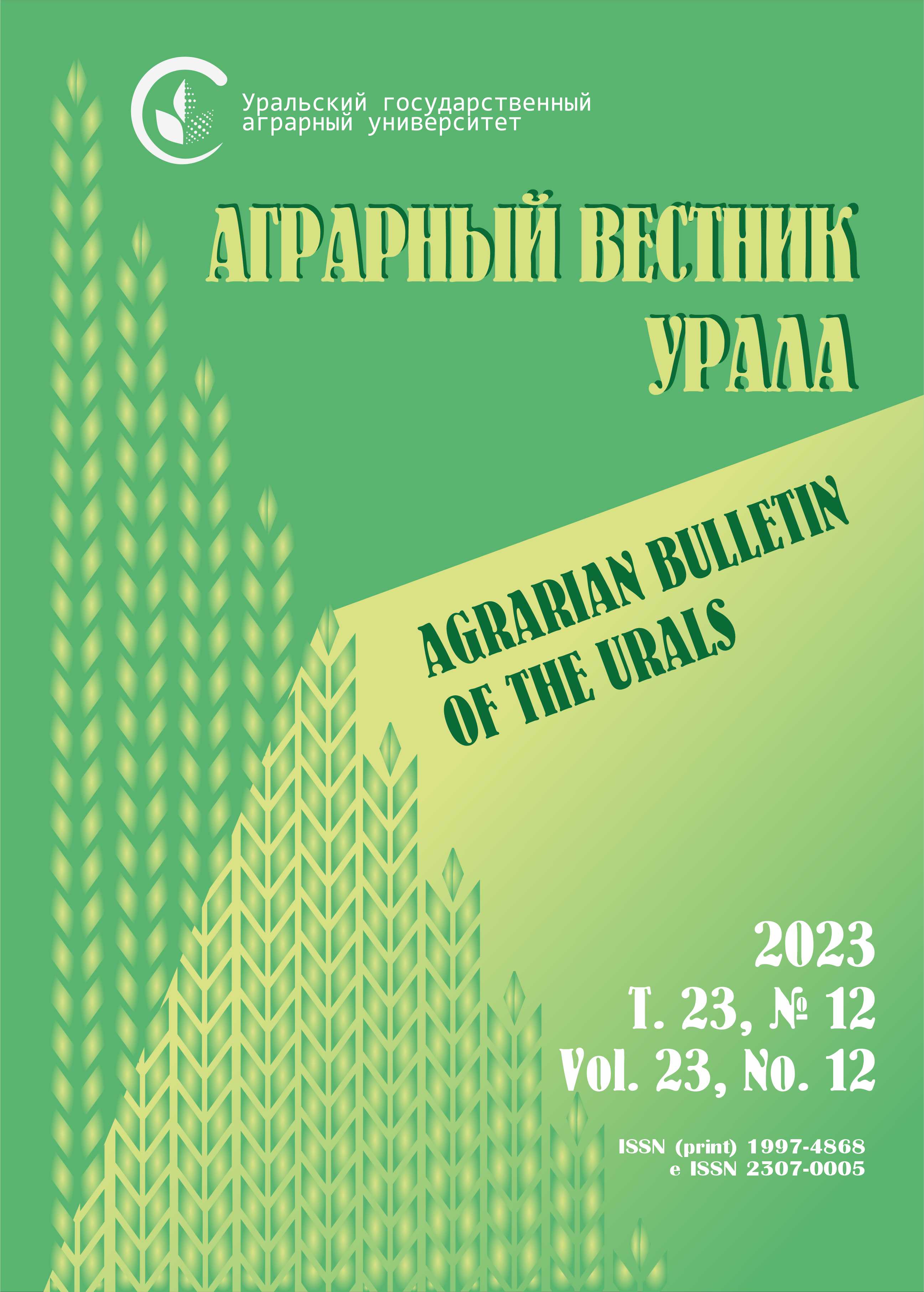Ekaterinburg, Ekaterinburg, Russian Federation
Abstract. The purpose of the work was to evaluate the effect of the microbiological preparation BIOR-AV on the structure, morphological characteristics and productivity of the grass mixture of Bromus inermis Leyss. and Elymus fibrosus (Schrenk) Tzvelev during the reclamation of planned clay dumps. Methods. Studies of experimental and control crops planted in 3 replicates within an area of 25 m2 were carried out during the growing seasons of 2001–2010. Projective cover and above-ground phytomass were determined on survey plots of 0.5 × 0.5 m; in each option, at least 15 plots were laid out. The dynamics of the morphological structure of vegetative and generative shoots was analyzed, and an agrochemical analysis of the substrate was carried out. Results. The positive effect of using the microbiological preparation during accelerated reclamation of dumps without applying fertile soil on the height, weight and length of leaves of vegetative and generative shoots; the number and size of structural elements of the inflorescences of the tested cereals (the length of the inflorescence, the number of branches in the inflorescence, the number of flowers, the number of spikelets, the weight of the inflorescence), and the sowing qualities of the seeds has been established. An increase in the content of the main elements of mineral nutrition in the substrate with the addition of the microbiological preparation: total nitrogen (1.6 times), available phosphorus and potassium (2 times), humus (5 times), as well as an increase in pH values from acidic to slightly acidic was revealed. The scientific novelty of the work: for the first time, in the conditions of the Middle Urals, monitoring studies of the effectiveness of the microbiological preparation on the structure, morphological parameters and productivity of a grass mixture of B. inermis and E. fibrosus were carried out on unsuitable clay substrates.
grass mixture, Bromus inermis, Elymus fibrosus, productivity, clay substrates, microbiological preparation, agricultural use, reclamation
1. Strategiya razvitiya agropromyshlennogo kompleksa Sverdlovskoy oblasti na period do 2035 goda. Postanovlenie pravitel'stva Sverdlovskoy oblasti № 386-PP ot 28.06.2019 g. [Elektronnyy resurs] URL: https://docs.cntd.ru/document/561427328 (data obrascheniya: 15.09.2023).
2. Nauchno obosnovannaya zonal'naya sistema zemledeliya Sverdlovskoy oblasti: kollektivnaya monografiya (dopolnennaya, pererabotannaya) / Pod obsch. red. d. s.-h. n. N. N. Zezina. Ekaterinburg: OOO «Dzhi Laym», 2020. 372 s.
3. Akimenko A. S. Formirovanie sevooborotov i struktury posevnyh ploschadey dlya polucheniya zadannogo kolichestva produkcii s uchetom prirodno-resursnogo potenciala // Zemledelie. 2020. № 4. S. 19-21. DOI:https://doi.org/10.24411/0044-3913-2020-10405. EDN: https://elibrary.ru/HSYVVM
4. Timoshkin O. A., Trishina V. A. Vliyanie sposoba poseva i normy vyseva na formirovanie agrocenoza i urozhaynost' semyan kostreca bezostogo // Agrarnaya nauka Evro-Severo-Vostoka. 2023. № 24 (4). S. 656-663. DOI:https://doi.org/10.30766/2072-9081.2023.24.4.656-663. EDN: https://elibrary.ru/OYGRME
5. Karlova I. V. Sovershenstvovanie priemov vozdelyvaniya i ispol'zovaniya polividovyh senokosno-pastbischnyh travostoev s kostrecom bezostym v usloviyah lesostepi Srednego Povolzh'ya: dis. … kand. s.-h. nauk. Kinel': Samarskiy gosudarstvennyy agrarnyy universitet, 2019. 232 s. EDN: https://elibrary.ru/TWJRIF
6. Shipilov I. A., Honina O. V. Vysokoproduktivnye travosmesi dlya uluchsheniya vyrodivshihsya senokosnyh i pastbischnyh travostoev // Sel'skohozyaystvennyy zhurnal. 2022. № 4 (15). S. 16-27. DOI:https://doi.org/10.25930/2687-1254/002.4.15.2022. EDN: https://elibrary.ru/PODTPH
7. Vlasenko M. V., Rybashlykova L. P., Turko S. Y. Restoration of Degraded Lands in the Arid Zone of the European Part of Russia by the Method of Phytomelioration // Agriculture. 2022. Vol. 12. No. 3. DOI:https://doi.org/10.3390/agriculture12030437. EDN: https://elibrary.ru/XWLPTR
8. Vlasenko M. V., Turko S. Yu., Rybashlykova L. P. Effektivnye tehnologii vosstanovleniya degradirovannyh zemel' i sozdaniya vysokokachestvennyh senokosov v basseyne reki Don // Agrarnyy vestnik Urala. 2023. № 05 (234). S. 14-25. DOI:https://doi.org/10.32417/1997-4868-2023-234-05-14-25. EDN: https://elibrary.ru/CKDOVR
9. Osipenko R. A., Zaripov Yu. V., Zalesov S. V. Rekul'tivirovannye zemli kak rezerv kormovoy bazy zhivotnovodstva // Agrarnyy vestnik Urala. 2021. № 05 (208). S. 40-54. DOI:https://doi.org/10.32417/1997-4868- 2021-208-05-40-54. DOI: https://doi.org/10.32417/1997-4868-2021-208-05-40-54; EDN: https://elibrary.ru/WZLHFQ
10. Zezin N. N., Postnikov P. A., Tormozin M. A., Ponomarev A. B. Urozhaynost' klevera lugovogo v zavisimosti ot agroklimaticheskih usloviy Srednego Urala // Kormoproizvodstvo. 2020. № 6. S. 20-24.
11. Demina I. F. Vliyanie pogodnyh usloviy na urozhaynost' i kachestvo zerna yarovoy pshenicy v lesostepi Srednego Povolzh'ya // Agrarnaya nauka Evro-Severo-Vostoka. 2022. № 23 (4). S. 433-440. DOI:https://doi.org/10.30766/2072-9081.2022.23.4.433-440. EDN: https://elibrary.ru/DGUMPH
12. Fomin D. S., Yarkova N. N., Polyakova S. S. Urozhaynost' yarovogo yachmenya v zavisimosti ot gidrotermicheskih usloviy v usloviyah Srednego Predural'ya // Agrarnaya nauka Evro-Severo-Vostoka. 2022. № 23 (6). S. 852-859. DOI:https://doi.org/10.30766/2072-9081.2022.23.6.852-859. EDN: https://elibrary.ru/NWXTXV
13. Rassohina I. I., Platonov A. V., Laptev G. Yu., Chernikova N. V. Produktivnost' kleverotimofeechnoy travosmesi pri ispol'zovanii mikrobiologicheskih preparatov // Agrarnyy nauchnyy zhurnal. 2023. № 1. S. 41-47. DOI:https://doi.org/10.28983/asj.y2023i1pp41-47. EDN: https://elibrary.ru/ZPTXOY
14. Mihaylova N. N., Eliseeva L. V., Eliseev I. P. Primenenie podkormki mikrobiologicheskimi preparatami «Azotovit» i «Fosfatovit» na posevah goroha // Agrarnyy vestnik Urala. 2022. № 02 (217). S. 12-22. DOI:https://doi.org/10.32417/1997-4868-2022-217-02-12-22. EDN: https://elibrary.ru/DYCTTB
15. Teng Z., Chen Z., Zhang Q., Yao Y., Song M., Li M. Isolation and characterization of phosphate solubilizing bacteria from rhizosphere soils of the Yeyahu Wetland in Beijing, China // Environmental Science and Pollution Research. 2019. No. 26. Pp. 33976-33987. DOI:https://doi.org/10.1007/s11356-018-2955-5. EDN: https://elibrary.ru/KYFTQQ
16. Rawat P., Das S., Shankhdhar D., Shankhdhar S. C. Phosphate-Solubilizing Microorganisms: Mechanism and Their Role in Phosphate Solubilization and Uptake // Journal of Soil Science and Plant Nutrition. 2021. No. 21. Pp. 49-68. DOI:https://doi.org/10.1007/s42729-020-00342-7. EDN: https://elibrary.ru/MLDDHT
17. Astriani M., Zubaidah S., Abadi A. L., Suarsini E. Pseudomonas plecoglossicida as a novel bacterium for phosphate solubilizing and indole-3-acetic acid-producing from soybean rhizospheric soils of East Java, Indonesia // Biodiversitas. 2020. No. 21. Pp. 578-586. DOI:https://doi.org/10.13057/biodiv/d210220. EDN: https://elibrary.ru/SGCMFK
18. Phyu K., Myo M., San S., Zaw K., Lynn T. Study on Plant Growth Promoting Activities of Azotobacter Isolates for Sustainable Agriculture in Myanmar // Journal of Biotechnology & Bioresearch. 2019. Vol. 1. No. 5. Pp. 1-6. JBB.000524.2019.
19. Chandran H., Meena M., Swapnil P. Plant growth-promoting rhizobacteria as a green alternative for sustainable agriculture // Sustainability. 2021. Vol. 13 (19). Article number 10986. DOI:https://doi.org/10.3390/su131910986. EDN: https://elibrary.ru/JUUKKS









